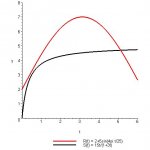stevenrand
New member
- Joined
- Mar 15, 2010
- Messages
- 5
My work for what I have so far is below the image...
[attachment=0:20rn5o2v]fmhq.jpg[/attachment:20rn5o2v]
For (A) I have 31.186 cubic yards beause I did the integral of R(t) from zero to six.
(B) This is just a guess...I am not sure how to do this: Y(t) = 2500 + S(t) - R(t)???
(C) I think I need to plug in 4 for t (in my equation from part B) but I do not feel like B is right so I didn't do it.
(D) Just based on a graph I thought it may be at 4.5 hours?
[attachment=0:20rn5o2v]fmhq.jpg[/attachment:20rn5o2v]
For (A) I have 31.186 cubic yards beause I did the integral of R(t) from zero to six.
(B) This is just a guess...I am not sure how to do this: Y(t) = 2500 + S(t) - R(t)???
(C) I think I need to plug in 4 for t (in my equation from part B) but I do not feel like B is right so I didn't do it.
(D) Just based on a graph I thought it may be at 4.5 hours?


